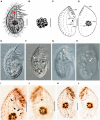A New Protocruzia Species (Ciliophora: Protocruziida) Isolated From the Mariana Trench Area
- PMID: 34745044
- PMCID: PMC8564289
- DOI: 10.3389/fmicb.2021.743920
A New Protocruzia Species (Ciliophora: Protocruziida) Isolated From the Mariana Trench Area
Abstract
A new species of Protocruzia, isolated from the deep-sea Pacific Ocean (>3,000-m depth) in the vicinity of the Mariana Trench, is described based on morphological and molecular data. The systematic status of the ciliate genus Protocruzia has long been highly ambiguous, and Protocruzia species have been assigned to an independent class until recently. In the present study, we described Protocruzia marianaensis sp. n. as a small (25-32 × 14-17 μm in vivo) drop-shaped ciliate, with longitudinal furrows along the ciliary rows on the right side, six adoral membranelles, eight somatic kineties, and one macronucleus comprising 7-11 nuclear globules. Phylogenetic analyses inferred from small subunit rRNA gene sequences revealed that seven Protocruzia species in the phylogenetic tree formed a fully supported clade representing an independent class. Protocruzia marianaensis sp. n. was established to be most closely related to Protocruzia adhaerens, with a sequence similarity of 96.64%, and was found to be able to survive at both atmospheric pressure and hydrostatic pressure of 320 bar, thereby indicating effective barotolerance.
Keywords: Mariana Trench area; ciliate; deep sea; morphology; phylogeny.
Copyright © 2021 Liang, Wang, Dong, Mukhtar, Wang and Chen.
Conflict of interest statement
The authors declare that the research was conducted in the absence of any commercial or financial relationships that could be construed as a potential conflict of interest.
Figures




References
-
- Ammermann D. V. (1968). Die kernverhältnisse des ciliaten protocrucia depressa n. sp. Arch. Protistenk. 110 434–438.
-
- Cohn F. (1866). Neue infusorien im seeaquarium. Z. Wiss. Zool. 16 253–302.
-
- de Puytorac P. (1994). “Phylum ciliophora doflein, 1901,” in Traité de Zoologie, Infusoires Ciliés, ed. de Puytorac P. (Paris: Masson; ), 621–679.
-
- de Puytorac P., Grain J., Mignot J.-P. (1987). Précis de Protistologie. Paris: Societé Nouvelle des Éditions Boubée.
LinkOut - more resources
Full Text Sources

